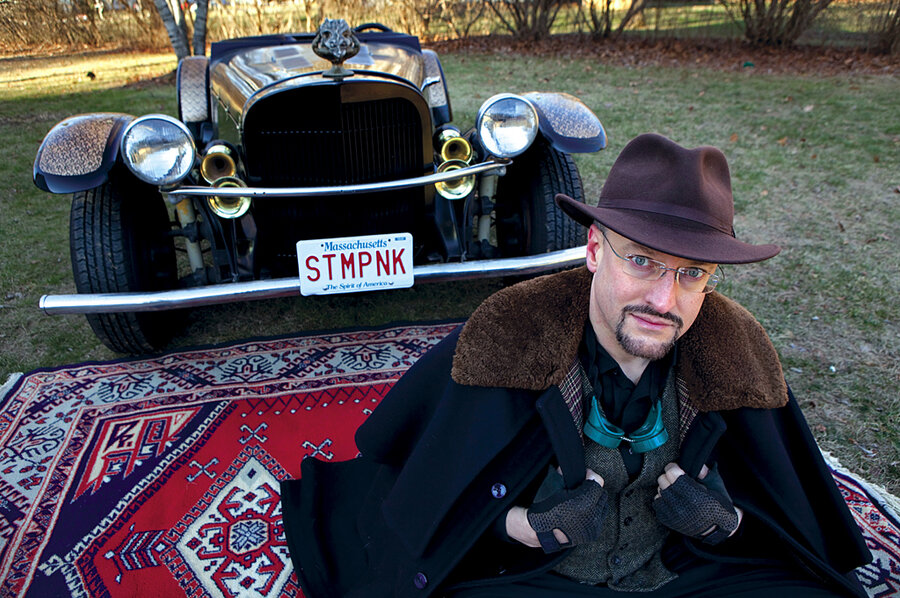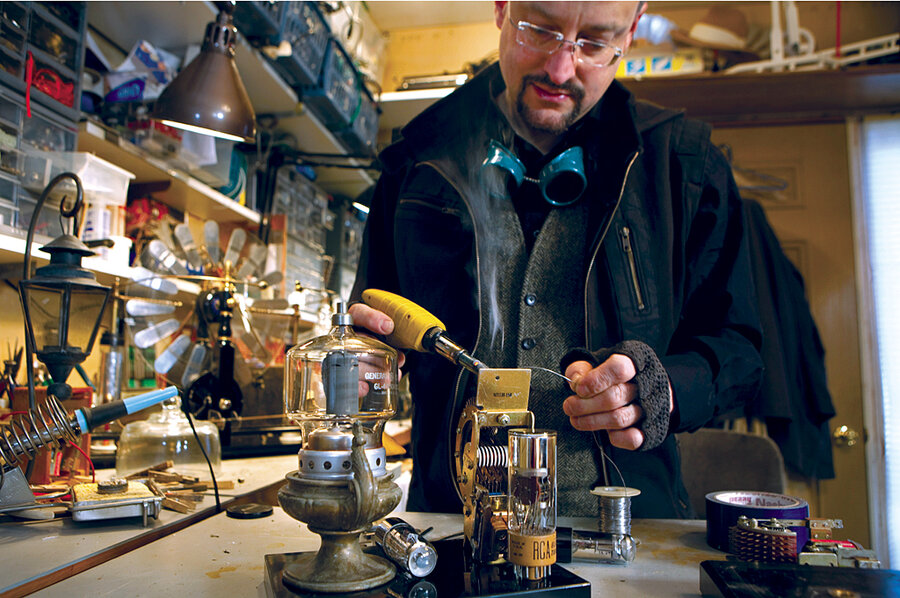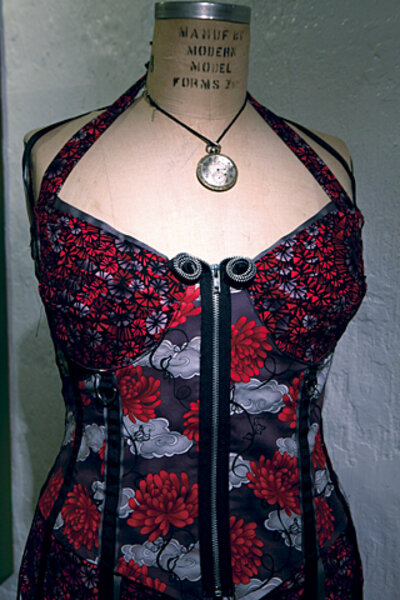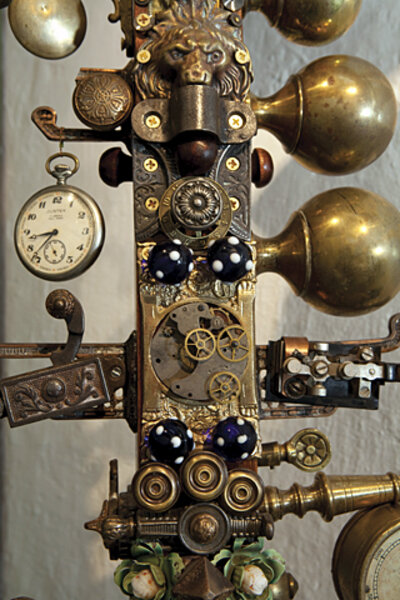Steampunk: The new Goth
Loading...
Some pop culture genres such as Tolkienesque fantasy imagine a magical past of strange races and global quests. Others, such as hard-core dystopian science fiction, warn against a future marred by apocalyptic meltdown.
Then comes steampunk, a hybrid vision of a past that might appear in the future – or a future that resides, paradoxically, in the spirit of another age.
No, you're not stuck in some goofy concept album by The Moody Blues. Steampunk is a fantasy made physical, made of brass and wood and powered by steam, born of the Industrial Age and inspired by the works of H.G. Wells and Jules Verne. It takes form both as an aesthetic movement and a community of artists; role-players; visionaries; and those who use the tools of literature, film, music, fashion, science, design, architecture, and gaming to manifest their visions.
"[Steampunk is] drawing on actual history. You can pull into it what you're into and put your spin on it. It's accessible yet expandable," says Jake von Slatt (real name: Sean Slattery, of Littleton, Mass.), who likens the philosophy behind steampunk to the open-source software movement. "There is a real focus on sharing, exploring things together, building community."
Steampunkers gather in conventions to exchange ideas – plus, they know how to dress to the nines and party like it's 1899.
Mr. von Slatt, who came of age in the era of punk rock, new wave, and Goth, has always been a tinkerer. Steampunk lets him "revisit youthful enthusiasms," he says. Now he creates intricately crafted anachronistic objects: for example, computer keyboards taken apart and rebuilt with brass, felt, and keys from antique manual typewriters. He's transformed a 1989 school bus into a wood-paneled "Victorian RV," which he uses to travel to steampunk conventions.
Currently, he's "steampunking" a fiberglass, 1954-style Mercedes kit car, tricking it out with salvaged gauges and lights from other cars and gold filigree trim. Drawn to steampunk's "do-it-yourself, making something from nothing" mantra, von Slatt scavenges most of his components from the dump.
Roots in a 1960s TV series
Steampunk was first introduced as a literary subgenre. William Gibson and Bruce Sterling's 1990 novel "The Difference Engine" popularized the idea of an alternate history where the Industrial Revolution-level technology of pistons and turbines, not electricity, powers modern gadgets, as Victorians might have designed them. But even way back in 1960s, the television series "The Wild Wild West" helped define the genre. The sci-fi western featured a train outfitted with a laboratory and featured protagonists who were gadgeteers.
Today, steampunk's reach has exploded, from Boston to San Francisco's Bay Area, to Britain, New Zealand, Japan, and beyond.
"Steampunk is definitely growing in popularity," says Diana Vick, vice chair of Steamcon, an annual convention in Seattle that doubled its attendance when it held its second meeting in November. "I believe it is due in part to the fact that it is a rejection of the slick, soulless, mass-produced technology of today and a return to a time when it was ornate and understandable."
This year, Steamcon celebrated what its website called the Weird Weird West. It notes: "Imagine the age of steam on the wild frontier ... roughriders on mechanical horses, mad inventors ... mighty steam locomotives ... airships instead of stagecoaches."
Every culture that embraces steampunk seems to make it their own. Patrick Barry, a member of New Zealand's League of Victoria Imagineers, has seen myriad international examples. "All have a different flavour, world vision and cultural base for the artists and writers to draw from and it shows," he writes via e-mail. Even in his tiny hometown of Oamaru, steampunk has taken off. Three groups have recently mounted an exhibition, a fashion show, and run several events. "Oamaru has a population of about 13,000 people. We had 11,000 people visit the exhibition over its six week [run]."
Previously, most works in the genre would have been set only in the Industrial Age. Over time, explains Dexter Palmer, author of the novel "The Dream of Perpetual Motion," the term "steampunk" has undergone "definition creep." "Nowadays the label's much more comprehensive, and seems to refer to any retrofuturistic or counterfactual work that features machines with lots of gears, or lighter-than-air flying craft, or similar sorts of things."
Some works have been retroactively embraced as part of the genre. For example, Terry Gilliam's dystopian satire, "Brazil," is now considered steampunk even though the film was not called steampunk when it was released in 1985.
In Mr. Palmer's novel, a greeting-card writer who is imprisoned aboard a zeppelin must confront a genius inventor and a perpetual motion machine. The author created a set of rules for his fictional universe: While things might be "scientifically implausible" to the reader, they would be "self-consistent and plausible to the inhabitants of the imaginary world." He based his ideas on source materials that predicted life in the year 2000 and then designed gadgets that seemed modern, but used turn-of-the-century tech. For example, there's an answering machine in the novel that functions by recording to a wax cylinder.
'It wants to teach us things'
"One of the really wonderful things about Steampunk is that it, more than any other subculture, seems to want to teach us things," von Slatt wrote on his blog at steampunkworkshop.com. And, like the punk and Goth movements before it, steampunk teaches another way of looking at the world.
Ms. Vick adds that another appeal lies in its largely optimistic and romantic, not dark and cautionary, outlook. "We also embrace and foster good manners and dressing up, which are both sorely lacking in society today," she says.
Indeed, dedicated steampunkers are lured by fashion. To dress up as a privateer and pilot flying machines powered by "lift-wood," or play a mad scientist who meddles in alchemy, the required accouterments include corsets, top hats, and lace-up boots; military medals, parasols, and aviator goggles.
Bruce and Melanie Rosenbaum aren't particularly into costuming, but when attending an event they will break out period garb. Their businesses, ModVic and SteamPuffin, offer home remodeling and design services for steampunking Victorian-era homes, an idea they applied to their own 1901 house in Sharon, Mass. They loved the turn-of-the-century fantasy but, Bruce says, "you don't want to live in the 19th century in terms of conveniences." So they retrofitted modern appliances or hid them behind facades of functional art. Combining old and new, their living room sports a plasma TV framed by an antique wooden mantel.
Upstairs, Bruce's attic office incorporates portholes, a bank vault door, and computer workstation made from an antique desk and pipes from a pump organ. You can almost see the ghost of Jules Verne hammering out a few e-mails.
"How much more fun is it to make something ornate and beautiful, rather than boring and unadorned?" asks Melanie. The couple is working on a book project, and recently curated two exhibits in the Boston area.
Tom Sepe, an artist exhibiting in one of them, the "Steampunk Form & Function" show at the Charles River Museum of Industry & Innovation in Waltham, Mass., shipped his "Whirlygig," a "steam-electric-hybrid motorcycle," from his workshop in Berkeley, Calif. The circus performer discovered steampunk via the Burning Man art community, and looks at his life as art. "Every choice we make is part of a performance," he says. "Every object we make or touch becomes an artifact of who we are and how we have been."
For Mr. Sepe, "three crucial elements" keep him engaged in the steampunkmaker culture: the "warmth factor" of its handmade materials, its functionality, and whimsy – "free thinking imagination and fun." Unlike other art forms, he says, "It doesn't take itself too seriously."
And whereas other genre fans can niggle over the small stuff, steampunk tends to be more open-ended. Jeff Mach, one of the partners behind New Jersey's Steampunk World's Fair, remembers Goths back in the 1990s sniping at one another for not being "Goth enough." No so with this latest, more inclusive cultural mashup. "It's not starting from a single point but many points," he says.
Many suggest steampunk is the next Goth, or even bigger. "I think this is the beginning of steampunk as a new sort of thing, as a pop culture phenomenon," says von Slatt. "I think it's the tip of the iceberg."









